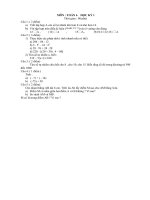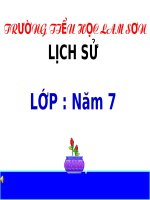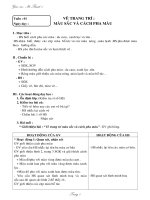Tài liệu Japan Economics/Fixed Income Weekly doc
Bạn đang xem bản rút gọn của tài liệu. Xem và tải ngay bản đầy đủ của tài liệu tại đây (802.84 KB, 24 trang )
ANALYST CERTIFICATIONS AND IMPORTANT DISCLOSURES ARE IN THE DISCLOSURE APPENDIX. FOR OTHER
IMPORTANT DISCLOSURES, PLEASE REFER TO .
CREDIT SUISSE SECURITIES RESEARCH & ANALYTICS BEYOND INFORMATION
®
Client-Driven Solutions, Insights, and Access
Japan Economics/Fixed Income
Weekly
Focus: the largest trade deficit in 1Q/2013 ········ 2
The trade balance recorded a deficit of ¥922.0 billion in seasonally adjusted
terms, resulting in the largest-ever quarterly deficit of ¥2.75 trillion (2.3% of
GDP) in the January-March quarter. Export volume rose +1.8% mom, recording
the first recovery in three months, helped by the general machinery and
transport equipment sectors, which seem to have opted to reduce product
prices. The terms of trade, meanwhile, continued to deteriorate as the yen
depreciated. As the country’s external balance has deteriorated persistently, its
capacity to recycle savings abroad should have shrunk further.
Fixed income market update ·························· 4
Since the BOJ announced new monetary easing measures at its policy meeting
on 4 April, the JGB market has been unstable with yields having risen
throughout the yield curve except for the 12yr-14yr zone, and volatility remains
high in all maturities.
Business cycle update ·································· 7
Money and credit update ····························· 14
Policy update ············································ 16
Fiscal policy: the US and Japanese governments officially reached agreement
on Japan’s participation in Trans-Pacific Partnership (TPP) trade negotiations.
Upcoming Indicators/Events ························· 17
March nationwide CPI (26th Apr): core CPI is expected to be -0.2% yoy
Japan Economic Forecasts ·························· 20
JGB Yield Forecasts ··································· 20
Recent Publications
Japan Economic Adviser: What matters is the balance between capex and
consumption (18 April 2013)
Research Analysts
Hiromichi Shirakawa
+81 3 4550 7117
Takashi Shiono
+81 3 4550 7189
Tomohiro Miyasaka
+81 3 4550 7171
18 April 2013
Fixed Income Research
18 April 2013
Japan Economics/Fixed Income Weekly 2
Focus: Customs-cleared trade for March
The trade balance recorded a deficit of ¥922.0 billion in seasonally adjusted terms,
resulting in the largest-ever quarterly deficit of ¥2.75 trillion (2.3% of GDP) in the
January-March quarter.
Export volume rose +1.8% mom, recording the first recovery in three months, helped
by the general machinery and transport equipment sectors, which seem to have opted
for to reduce product prices.
The terms of trade, meanwhile, continued to deteriorate as import prices rose. As the
country’s external balance has deteriorated, its capacity to recycle savings abroad
has shrunk.
Customs-cleared trade data for March continued to record a wide trade deficit of ¥922.0
billion (seasonally adjusted). While nominal imports pulled back -1.2% after a surge in
February (+6.9%), nominal exports continued to grow +1.6% after +1.3% in February. Our
own seasonally adjusted estimates show the export volume index turned positive at +1.8%
mom in March for the first time in three months, while import volume fell -1.5% after +4.1%.
On the other hand, significant deterioration in the terms of trade continued as the change
in import prices (+1.1%) outpaced that of exports (-0.2%).
Exhibit 1: Trade balance, billion yen
Exhibit 2: Import and export volumes, mom%
-1,200
-1,000
-800
-600
-400
-200
0
200
400
600
800
2011/1
2011/3
2011/5
2011/7
2011/9
2011/11
2012/1
2012/3
2012/5
2012/7
2012/9
2012/11
2013/1
2013/3
Trade balance, billion yen
-15.0%
-10.0%
-5.0%
0.0%
5.0%
10.0%
2011/3
2011/6
2011/9
2011/12
2012/3
2012/6
2012/9
2012/12
2013/3
Export volumes (mom%)
Import volumes (mom%)
Source: MoF, Credit Suisse
Source: MoF, Credit Suisse
By item, rebounds in the volume of exports were observed for chemicals, general
machinery, and transport equipment to the US and China, but exports to the EU remained
weak. Meanwhile, exports of general machinery, chemical products, and electrical
equipment to other parts of Asia were resilient. Import volume fell particularly sharply for
mineral fuels, foods, and chemicals, which significantly increased last month.
On a quarterly basis, growth in nominal imports (+9.6% qoq) outpaced growth in exports
(+7.2%) in the Jan-Mar period, leading to the historically highest deficit (¥2.75 trillion, -
2.3% of GDP) in quarterly aggregate terms. In real terms, export volume remained almost
unchanged (+0.9%), while import volume expanded +3.5% in the Jan-Mar period.
As we discussed in Japan Economic Analysis Issue No. 37 (22 February 2013), export
volume continues to lack upward momentum despite a cyclical upswing in global
production activity and an improvement in price competitiveness stemming from the
weaker yen. We see little prospect of the trade balance improving significantly any time
soon given that (1) structural pressures such as societal aging and industrial "hollowing
out" continue to drive up import volume, and (2) the yen's devaluation has a
disproportionately large impact on (predominantly foreign-denominated) import prices.
Hiromichi Shirakawa
+ 81 3 4550 7117
Takashi Shiono
+81 3 4550 7189









